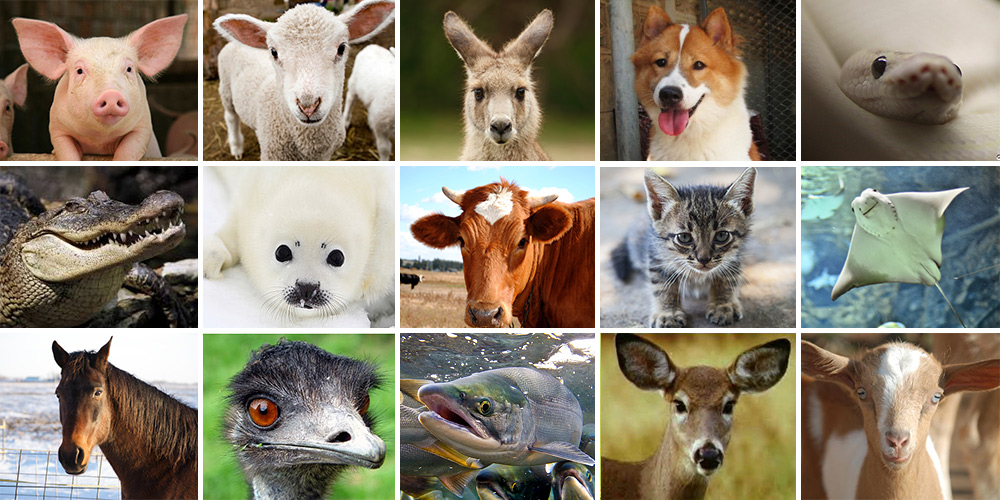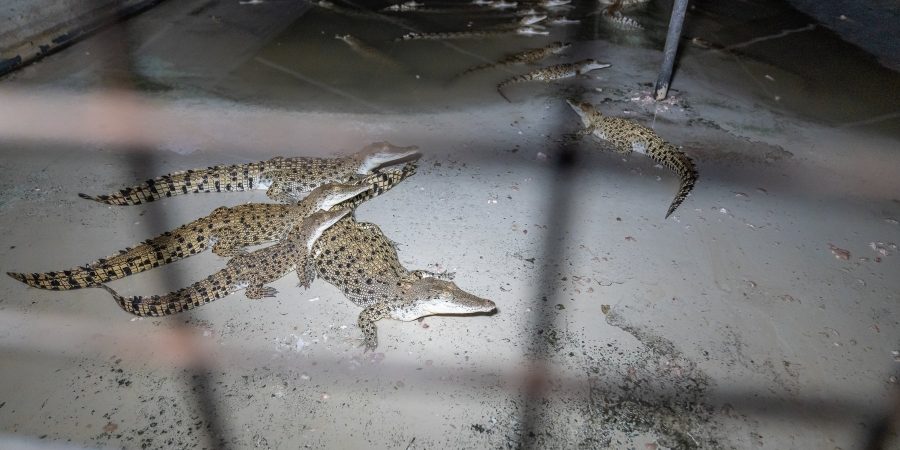From belts and boots to car seats and key rings, whether it be for ‘fashion’ or accessories, leather is everywhere. But what – or more accurately, who – is leather made from, and how?
What is ‘leather’ and where does it come from?
While most people associate leather with cows, the reality is that many different animals are killed to make leather. Leather is made from the skin of animals – once an animal’s skin is removed, it must be preserved through a process called ‘tanning’, which uses strong chemicals to prevent the skin from decomposing.
The tanning methods used to make leather products from their skin are toxic to both people and the environment. Many people are sceptical about the processing involved with vegan leathers – but animal ‘leather’ is processed using harmful chemicals, too.
The animals who are killed for leather
A wide variety of animal species are killed to make leather — most notably cattle, but also pigs, goats, sheep, crocodiles, snakes, sting rays, seals, rabbits, emus, deer, fish, kangaroos, horses, cats and dogs. Even baby animals don’t escape the leather industry — with the skins of calves, kids and lambs considered a particularly ‘valuable raw material’ by the industry because of its softness.
Hundreds of thousands of days-old ‘bobby’ calves born into the dairy industry are slaughtered every single year in Australia, with their skins then used to make boots, bags and other products for the fashion industry. Even unborn calves (called ‘slinks’), whose pregnant mothers are killed in slaughterhouses, may be skinned too. The skin from these premature animals is unfortunately particularly sought-after for its ‘delicateness’ – but if more consumers knew who was behind the leather products, most would likely choose kinder alternatives.
This image contains content which some may find confronting

Isn’t leather just a ‘by-product’?
It is a common misconception that leather is simply a ‘by-product’ of meat production. Whilst it’s true that animals are often used for their meat too (such as in the case of cattle and sheep), their skin can still represent a significant portion of the income made on the sale of their body parts – contributing to the overall commercial viability of the enterprise.
So, leather is rather a ‘co-product’ of the meat industry (not just a ‘by-product’), and may contribute to driving demand for more animals to be raised and killed.
Australian animals used for their skin endure cruelty
Caught up in profit-driven industries in Australia, animals like cattle and sheep are denied the same legal protection given to most other animals. As a result, these sensitive animals are routinely subjected to painful procedures like castration, de-horning, branding and mulesing — often without any pain relief.
These animals are also raised on such large and remote stations that monitoring and care for them is infrequent — and injured and sick animals may be forced to suffer for long periods in pain, untreated and unnoticed.
And ultimately, all animals used for their leather must face the stresses of slaughter.
Even beloved Australian icons are slaughtered for their skins
Kangaroos – one of Australia’s most iconic animals – are killed in their millions every year, with their skins used to make sports shoes, gloves, accessories and souvenirs. Tragically, during the commercial killing of adult kangaroos, thousands of dependent joeys become ‘collateral damage’ of this brutal slaughter. Considered a ‘waste product’ to the commercial industry, these babies are either decapitated, bludgeoned to death, or escape only to starve without their mothers who were killed for their skin and meat.
The commercial kangaroo killing industry is the biggest land-based slaughter in the world.
Leather made from kangaroo skins is referred to as ‘K-leather’ by industry. Buyers and sports enthusiasts often don’t know that what they’re wearing is fuelling this senseless trade in a big way. The Australian Government has tried to sell the issue of kangaroo skins as a ‘solution’ to an ‘overpopulation’ of kangaroos in Australia – but there is currently no accurate population data, making the slaughter of kangaroos not only cruel, but completely reckless.
The Australian and global community is outraged, and has placed pressure on sporting brands to end this barbaric slaughter. This has been effective, and global sporting giants Nike and Puma recently announced they will shift away from this cruel wildlife trade. But Adidas continues to use kangaroo skins to make their soccer balls and shoes.
We know that kangaroos are used for meat, particularly pet food, but the skin trade is the whole thing. The commercial killing of kangaroos couldn't stand up on its own two feet without the skin trade.
Australia’s crocodiles are not immune
Australia slaughters just over 150,000 crocodiles annually, and fuels 60% of the world’s crocodile skin trade.
These sentient animals are both stolen from the wild and bred in cruel factory farms in Australia’s top end.
Crocodiles are kept in barren, concrete pens that reflect nothing of their wild habitats, until they are slaughtered at just 2-3 years old. It takes the suffering and slaughter of 3-4 crocodiles to make just one Hermes birkin bag. The crocodile skin industry’s claims of ‘conservation’ and ‘humane’ practices are nothing more than a deceptive greenwashing tactic. In reality, it ruthlessly profits from the undeniable suffering of thousands of crocodiles per year.
This image contains content which some may find confronting

The animals behind imported ‘leather’ also suffer a grim fate
Australia also imports leather and leather products from various countries — including some with no animal welfare laws, and appalling track records of animal cruelty.
China, the world’s largest exporter of leather, kills millions of cats and dogs for their skin and meat every year. India’s leather trade is also one of the biggest in the world. As many of the country’s provinces forbid the slaughter of ‘sacred’ cows, these animals are often forced to walk long distances across borders to be brutally killed in neighbouring provinces and countries. Along the gruelling journey, exhausted animals can be beaten and tortured with chilli and tobacco rubbed into their eyes to make them keep walking.
There is no requirement to label leather products, making it extremely difficult and often impossible for a consumer to ascertain which species of animal the ‘leather’ has come from, and in which country he or she was raised and killed for their skin.
People and the planet suffer for leather, too
While leather is often promoted as being a ‘natural’ fibre, the the tanning methods used can involve an array of toxic chemicals which permanently alter the protein structure of the skin.
Workers in some international tanneries have been documented to suffer from skin diseases and respiratory illnesses caused by exposure to tanning chemicals. These chemicals, including chromium salt can also cause extreme pollution to air, soil and water, resulting in devastating effects to local human and animal populations.
There are kinder, animal-free leathers that exist right now!
There is no such thing as ‘renewable’ or ‘sustainable’ animal-derived leathers. And animal leathers are in no way organic.
As more people become aware of the true cost of leather to animals, people and the environment, demand is growing for kinder alternatives.
Organic and sustainably sourced cotton, linen, hemp, and man-made cellulosic materials derived from plant matter likeTencel and bamboo lyocell are all fantastic and commonly used raw materials. There are also some lesser-known ‘leathers’ growing in popularity, like apple leather, processed mango waste, mycelium and other bio-materials; these can even be embossed to replicate the scales of crocodiles while leaving these magnificent and beautiful animals to live in the wild where they belong.
Newer technologies are giving rise to more eco-friendly, plant-based materials, and many retailers and brands now offer a range of leather-free bags, shoes, and clothing that are fashionable and cruelty-free.
Shop kindly to make a difference for animals
Tread softly for animals and the planet by choosing cruelty-free alternatives to leather. You don’t even need to step out your front door – here are just some of the great online stores that specialise in cruelty-free shoes, handbags, and other leather-free apparel:
- Vegan Style (delivers across Australia and internationally)
- Moo Shoes (US-based)
- Vegetarian Shoe Company (UK-based)
More ways you can help animals who fall victim to the leather trade
Here are more ways you can help animals stuck in a cycle of suffering for leather:
- Share this article to help inform others of the truth about leather.
- Contact ADIDAS and urge them to stop using kangaroos to make sports shoes.
- Check out the Collective Fashion Justice manifesto and join the movement to promote more plant-based leather in fashion and furniture.
- Be a conscious consumer – remember to always check the label, and ask your local retailers to stock sustainable animal-free options that are kinder for all.







